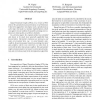Free Online Productivity Tools
i2Speak
i2Symbol
i2OCR
iTex2Img
iWeb2Print
iWeb2Shot
i2Type
iPdf2Split
iPdf2Merge
i2Bopomofo
i2Arabic
i2Style
i2Image
i2PDF
iLatex2Rtf
Sci2ools
115
Voted
ACSD
2005
IEEE
2005
IEEE
Improved Decomposition of STGs
Signal Transition Graphs (STGs) are a version of Petri nets for the specification of asynchronous circuit behaviour. It has been suggested to decompose such a specification as a first step; this leads to a modular implementation, which can support circuit synthesis by possibly avoiding state explosion or allowing the use of library elements. In a previous paper, the original method was extended and shown to be much more generally applicable than known before. But further extensions are necessary, and some are presented here, e.g.: to avoid dynamic autoconflicts, the previous paper insisted on avoiding structural auto-conflicts, which is too restrictive; we show how to work with the latter type of auto-conflicts. This and another simple extension makes it necessary to restructure presentation and correctness proof of the decomposition algorithm.
Related Content
| Added | 24 Jun 2010 |
| Updated | 24 Jun 2010 |
| Type | Conference |
| Year | 2005 |
| Where | ACSD |
| Authors | Walter Vogler, Ben Kangsah |
Comments (0)

